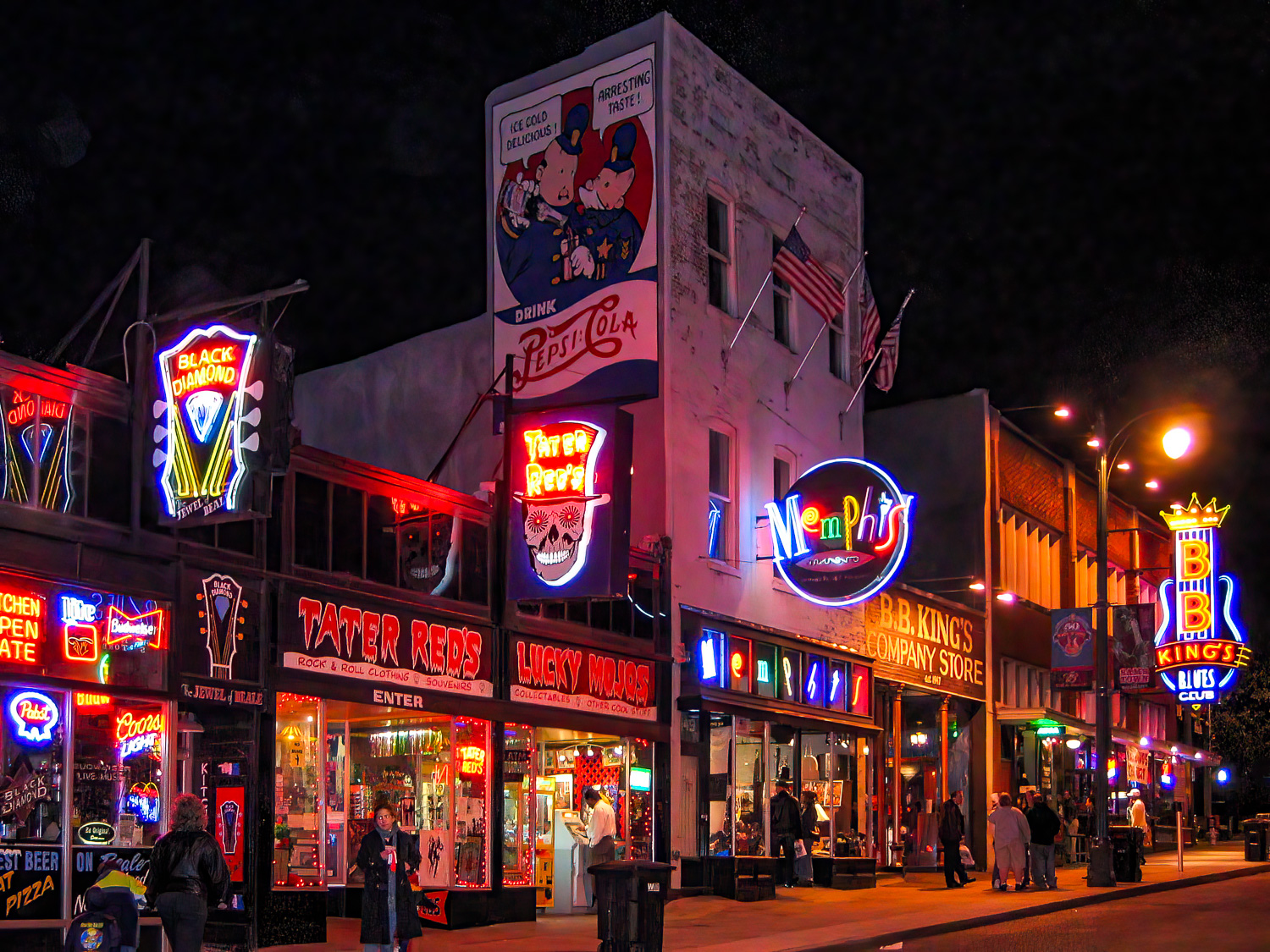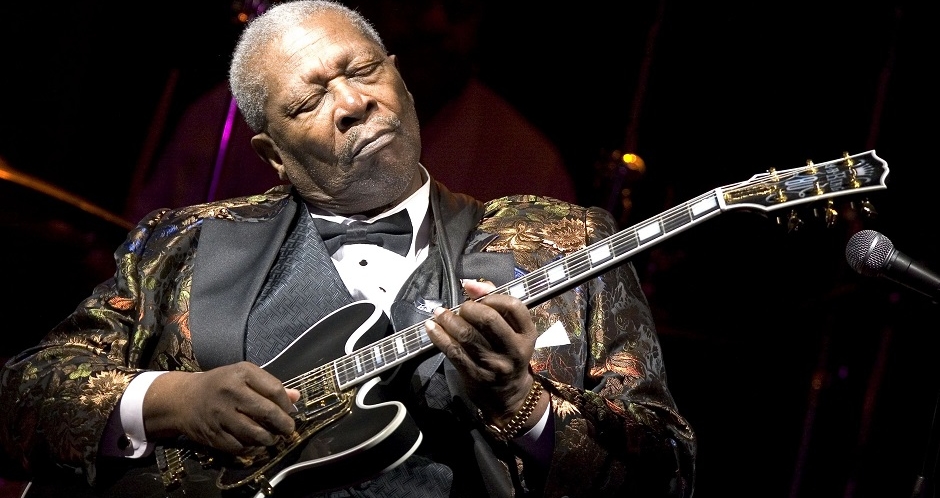There’s more to Memphis than Graceland, and much of it has to do with music!

Memphis hugs the east bank of the Mississippi River in the southwest corner of Tennessee. If you’re a Bob Dylan fan, you probably know that the Highway 61 he pays homage to in his “Highway 61 Revisited” album goes through Memphis as it follows the river down to New Orleans. This is known as “America’s Blues Highway.” Although there are motels on Highway 61, we stayed downtown. Most of what we wanted to see was located there so we were able to get around by walking or taking the streetcar.
While walking around, we were constantly reminded of Elvis. No surprise there. It was a beautiful spring day so, even when we weren’t looking for anything special, it was still enjoyable. If you like photography, you probably know that sometimes it’s the things that you’re not looking for that can be the most interesting. We eventually came upon the Arcade Restaurant. It’s been in Memphis since 1919 and is the oldest cafe in the city. Since we were hungry and since the sign said we could get “good Home style EATING at reasonable prices,” we decided to try them out. I don’t remember much about the meal so it must have been good. Had it been top notch or bottom notch, I’m sure I would have remembered.
(Mouse over any photo to see a caption, or click on it to enlarge and then use arrows to scroll through the images.)
Beale Street is, of course, the place to visit in Memphis. It’s considered to be “the Home of the Blues and the true birthplace of Rock n Roll.” Although the street is almost three miles long, the famous part spans only three blocks. Don’t worry however, you can find quite a variety of things to see and do in those three blocks. You’ll certainly find musicians on the street, so whether you’re tired or not, sit for a spell and enjoy the entertainment. Hungry? You might want to have some “Pork With An Attitude!” There’s even a wall — that’s right, just a wall — held up with some girders. It’s the remains of the Gallina Exchange Building. Built in 1891, it was gutted by fire in 1980 and the “temporary” girders were installed to support it. Decades later the wall still stands there and behind it sits the large patio section of Silky O’Sullivan’s (Where Every Day is St. Patrick’s Day), a famous pub that opened there in 1992. If you peek back at the patio you’ll probably see the Irish Diving Goats! Don’t ask me to explain.
Memphis has apparently become known for its murals. You can see many beautiful examples on the city’s Downtown Mural Guide. We stopped to look at the multi-paneled Blues Mural on Beale Street. There may be more in the area now but remember, these photos are from a trip there in 2006. As the evening begins to slowly seep into the city, the colorful neon lights begin to light up the street. And there, at 143 Beale Street near S. 2nd Street, you can’t miss B.B. King’s Blues Club. We spent a couple hours there enjoying the music as well as the beer. We even paid extra for the first glass of beer so that we could keep the souvenir glass. B.B. King passed away in 2015, but he was still touring in 2006. He was not at his club that night so I didn’t get any photos, but the image below shows him in New York City in 2006 performing in his 10,000 concert. Amazing!

When he started his career in Memphis in the late 40s, Riley B. King called himself Riley “Beale Street Blues Boy” King. That eventually became Riley “Blues Boy” King and finally, as we know, B.B. King. Fans of the Rolling Stones probably know that Mick and the gang toured with B.B. King in 1969. The Stones have always been open about how the blues were a great influence on their music. B.B. King said that the Stones 1968 album “Beggars Banquet” was his favorite and credits it as being “one that helped break down people’s prejudices.”
It’s hard to think about B.B King without picturing him with his guitar, “Lucille.” In the photo above you can probably tell from the shape of the headstock that it’s a Gibson. King often used three guitars in live performances, but the model that he seemed to love the best was the Gibson ES-355, which was the top-of-the-line Gibson semi-hollow body guitar. Though it has since closed, when we visited Memphis a Gibson Guitar factory was still located there. Since I like guitars and since two of my four guitars are Gibsons, I thought it would be an interesting place to visit. Although they don’t give visitors hard hats or safety glasses, you have to remember that this is a factory, so they have some signs warning you about the dangers.
If I remember correctly, Gibson primarily made hollow-body and semi-hollow body guitars in Memphis. As you probably know, they’re the ones like the ES-135 and -355 that usually sport distinctive violin-looking “f-holes.” The solid bodies, like the Les Paul and the SG that you often see in rock bands, are made in Nashville. With the Memphis plant closed, all Gibsons are now made either in Nashville, the headquarters, or in Bozeman, Montana. Though I was disappointed that I didn’t see any Les Pauls in the works (I know some of you are Fender Strat folks but I happen to like Les Pauls) I still found the tour interesting. There was even a 24′ tall model of “Lucille.”
Having been steeped in Memphis blues and rock music for a couple of days, we had to visit one more place, Sun Records, where “Rock and Roll was born!” Sam Phillips started the studio in 1952 and within a few years he was recording the likes of B.B. King, Howlin’ Wolf, Ike Turner, Elvis Presley, Johnny Cash, Carl Perkins, Jerry Lee Lewis, and Roy Orbison. Looking back at the decade of the fifties, it’s difficult to image a better group of recording artists than this group. The studio was small and the old recording equipment was quaint, but if some of the songs those old artists sang still play in your head, you’d enjoy being there.
I hate to end this post on a somber note, but sadly, not everything in Memphis is fun to see. If your generation is younger than mine, you might remember this from history class. If you’re part of my generation, you might remember being in college in 1968 when, on April 4, Martin Luther King was assassinated while standing on the balcony of room 306 at the Lorraine Motel. The Lorraine had been one of the few black establishments, and one of the only motels providing accommodations to African Americans. King and other black leaders were in town to support 1,300 striking sanitation workers and were planning to hold a march that evening. That march, of course, never took place. The Lorraine Motel is now the National Civil Rights Museum and Room 306 remains exactly as it was on that tragic day.
I have no photos from inside the motel or museum. I was quite overwhelmed and just spent my time quietly looking at and reading exhibits. Unfortunately, King’s assassination was not the only tragedy in 1968. Two months later, on June 5, 1968, Robert F. (Bobby) Kennedy was assassinated. I sometimes wonder what might have been.